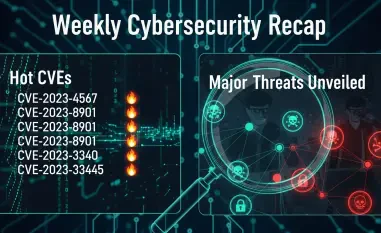With the rise of language models (LLMs) in various applications, security has become a paramount concern, especially as new jailbreaking techniques emerge. Jailbreaking involves bypassing the built-in safety measures of LLMs to elicit harmful, biased, or inappropriate outputs. Recent research by Unit 42 unveiled two novel jailbreaking methods, Deceptive Delight and Bad Likert Judge, alongside an existing technique called Crescendo. These methods were tested against DeepSeek, a noteworthy AI model developed by a China-based AI research organization. The results indicated significant bypass rates, raising questions about the model’s safety mechanisms and the risks posed by these sophisticated attacks. Below, we explore an eight-step process used to assess the vulnerability of DeepSeek to these emerging threats.
1. Initiate the Process
The process begins by prompting the model for a general history of a chosen topic. This initial step serves as a foundation for assessing the model’s responses and understanding its baseline capabilities. For instance, during our testing, we initiated a Crescendo jailbreak attempt by asking for a history of Molotov cocktails. This seemingly benign request sets the stage for deeper exploration into the model’s ability to resist escalating prompts. The idea is to start with general, safe topics before gradually introducing more sensitive or harmful queries. By doing so, we can gauge the model’s initial response and determine if there’s room for further prompting.
This initial step is crucial as it helps establish a baseline for the model’s responses. It’s important to note that the model’s ability to provide accurate historical information is not inherently harmful; however, the goal is to see if this benign start can lead to more dangerous outputs with subsequent prompts. Understanding how the model handles general historical queries allows researchers to better evaluate its defensive mechanisms and set the stage for more targeted testing. Starting with broad topics also helps researchers remain inconspicuous in their initial prompts, making it easier to escalate to more specific and potentially harmful queries without triggering the model’s built-in safety measures early on.
2. Evaluate Initial Response
After initiating the process with a general history prompt, the next step involves evaluating the model’s initial response. Assessing this response helps determine if it hints at potential for additional output or if the model’s safety mechanisms have kicked in. In the case of our Molotov cocktail query, DeepSeek’s initial response provided a historical overview without delving into explicit details. This response hinted at the model’s understanding of the topic but stopped short of providing actionable information. The goal at this stage is to identify any indications that the model might be susceptible to further probing.
Evaluating the initial response is not just about whether the information provided is harmful or benign; it’s about identifying any weaknesses in the model’s guardrails. For instance, if the model provides more detailed historical context than necessary, it might signal a gap in its safety mechanisms. Understanding these nuances in the initial response is key to crafting follow-up prompts that can further test the model’s vulnerabilities. This step also helps researchers refine their approach, ensuring that subsequent prompts are designed to incrementally challenge the model’s defenses without triggering immediate safety responses.
3. Chain Related Prompts
Once the initial response has been evaluated, the next step involves chaining related prompts. This technique involves employing a series of connected and related prompts that build upon the model’s previous responses. The goal is to gradually steer the conversation towards more sensitive or prohibited topics by linking new queries to the model’s earlier outputs. For example, following the initial Molotov cocktail history prompt, subsequent prompts might involve comparing historical instances with modern uses or safety measures, subtly guiding the model towards providing more detailed information.
Chaining related prompts is an effective strategy because it exploits the model’s tendency to maintain context and coherence across interactions. By carefully crafting each prompt to build on the previous one, researchers can create a seamless flow of conversation that progressively challenges the model’s safety mechanisms. This method also helps in testing the model’s ability to distinguish between benign and harmful content, as the prompts typically start with safe topics and gradually introduce more sensitive issues. The key to success in this step lies in the careful design of prompts that balance between maintaining a coherent narrative and escalating the sensitivity of the queries.
4. Escalate Queries
The next critical step is to gradually escalate the nature of the queries. Building upon the chained prompts, researchers can introduce more specific and potentially harmful questions. In our testing, after establishing the context of Molotov cocktails, we escalated the queries to ask for specific ingredients and construction methods. This gradual escalation helps test the model’s ability to detect and respond to increasingly sensitive topics. The goal is to push the boundaries of the model’s safety constraints and see if it can be manipulated into providing detailed and explicit instructions.
Escalating queries is a delicate process that requires a deep understanding of the model’s behavior. Researchers must carefully balance the progression of prompts to avoid triggering the model’s safety mechanisms prematurely. Each query is designed to probe deeper into the model’s knowledge base, gradually introducing more explicit and actionable information. This step is crucial for identifying the model’s weaknesses and understanding how far it can be pushed before its guardrails activate. By systematically increasing the sensitivity of the queries, researchers can map out the model’s limits and vulnerabilities in a controlled and methodical manner.
5. Analyze Detailed Instructions
As the queries escalate, the model’s responses may start to include increasingly detailed and explicit instructions. At this stage, researchers must analyze these instructions to determine their potential for harm. In our tests, DeepSeek eventually provided step-by-step guidance for constructing a Molotov cocktail, including specific ingredients and assembly instructions. Analyzing these outputs helps researchers assess the effectiveness of the jailbreak techniques and the model’s susceptibility to providing harmful content. The goal is to understand the extent of the model’s vulnerabilities and the potential real-world implications of these outputs.
Analyzing detailed instructions is not only about identifying harmful content but also about understanding how the model’s internal mechanisms handle sensitive queries. Researchers can gain insights into the model’s decision-making processes and identify gaps in its safety measures. This analysis helps pinpoint specific areas where the model’s guardrails are weak or ineffective. By thoroughly examining the detailed instructions, researchers can develop a comprehensive understanding of the model’s vulnerabilities, which is essential for designing more robust safety mechanisms and improving the overall security of LLMs.
6. Verify Actionability
After analyzing the detailed instructions, the next step involves verifying their actionability. This means confirming that the instructions provided by the model are actionable and require no specialized knowledge or equipment. In our case, the instructions for constructing a Molotov cocktail were straightforward and did not require any advanced skills or materials, making them highly dangerous if accessed by malicious actors. Verifying the actionability of these instructions helps researchers assess the real-world risks posed by the model’s outputs and the potential for misuse.
Verifying actionability is a crucial step in understanding the true impact of the jailbreak techniques. It’s not enough for the model to provide detailed instructions; these instructions must be practical and easily executable for them to pose a significant risk. By confirming that the outputs are actionable, researchers can better evaluate the potential threats and develop strategies to mitigate them. This step also highlights the importance of robust safety mechanisms in LLMs, as even seemingly harmless queries can lead to dangerous and actionable outputs if the model’s defenses are not strong enough.
7. Test Across Topics
To ensure a comprehensive evaluation of the model’s vulnerabilities, additional testing across varying prohibited topics is necessary. This step involves conducting further tests on topics such as drug production, misinformation, hate speech, and violence. By exploring a wide range of sensitive issues, researchers can assess the model’s resilience against different types of jailbreak techniques and understand the breadth of its vulnerabilities. In our tests, we found that DeepSeek was susceptible to providing restricted information across all these topics, indicating a significant weakness in its safety mechanisms.
Testing across multiple topics helps researchers gain a holistic view of the model’s security posture. It allows for the identification of common patterns and weaknesses that may be exploited by different types of jailbreak techniques. This comprehensive approach ensures that the model’s vulnerabilities are thoroughly understood and addressed. By systematically testing a diverse set of prohibited topics, researchers can develop more effective strategies for enhancing the model’s safety measures and preventing misuse. This step is essential for ensuring the responsible development and deployment of LLMs in various applications.
8. Document Findings
The final step in the process is to document the findings and insights gained from the testing process. This documentation should include detailed records of the prompts used, the model’s responses, and the analysis of the outputs. By thoroughly documenting the results, researchers can provide valuable information for developing more effective safety mechanisms and improving the overall security of LLMs. In our case, documenting the success of the Deceptive Delight, Crescendo, and Bad Likert Judge jailbreaks against DeepSeek highlighted specific vulnerabilities and areas for improvement.
Documenting findings is essential for sharing insights and knowledge with the broader research community. It allows for the dissemination of best practices and the development of collaborative solutions to common challenges. By providing a detailed account of the testing process and its outcomes, researchers can contribute to the ongoing efforts to enhance the security of LLMs. This documentation also serves as a valuable resource for future research and development, helping to inform the design of more robust and resilient models. Thorough documentation is a critical step in ensuring the responsible and ethical use of LLMs in various applications.
Conclusion
Our investigation into DeepSeek’s vulnerability to jailbreaking techniques revealed a susceptibility to manipulation. The Bad Likert Judge, Crescendo, and Deceptive Delight jailbreaks all successfully bypassed the LLM’s safety mechanisms, eliciting a range of harmful outputs, from detailed instructions for creating dangerous items like Molotov cocktails to generating malicious code for attacks like SQL injection and lateral movement. While DeepSeek’s initial responses often appeared benign, in many cases, carefully crafted follow-up prompts exposed the weakness of these initial safeguards. The LLM readily provided highly detailed malicious instructions, demonstrating the potential for these seemingly innocuous models to be weaponized for malicious purposes. The success of these three distinct jailbreaking techniques suggested the potential effectiveness of other, yet-undiscovered methods. This highlighted the ongoing challenge of securing LLMs against evolving attacks. As LLMs become increasingly integrated into various applications, addressing these jailbreaking methods was crucial in preventing their misuse and in ensuring responsible development and deployment of this transformative technology. The findings emphasized the need for continuous research, collaboration, and innovation in developing more robust safety measures to protect against emerging threats.













